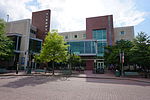Lomax African Methodist Episcopal Zion Church
19th-century Methodist church buildings in the United StatesArlington County, Virginia geography stubsChurches completed in 1894Churches in Arlington County, VirginiaChurches on the National Register of Historic Places in Virginia ... and 4 more
Methodist churches in VirginiaNational Register of Historic Places in Arlington County, VirginiaNorthern Virginia Registered Historic Place stubsVirginia church stubs

Lomax African Methodist Episcopal Zion Church is an historic African Methodist Episcopal Zion church located at 2704 24th Rd. South in Arlington, Virginia. It was built in 1922, and is a one-story, three bay by six bay, brick church building on a parged concrete foundation. It features two unequal-sized crenellated towers and brick buttresses along the facade and side elevations in the Late Gothic Revival style. Also on the property are two contributing resources, including a cemetery dating from circa 1894, and a parsonage built in 1951. The cemetery contains approximately 107 interments.It was listed on the National Register of Historic Places in 2004.
Excerpt from the Wikipedia article Lomax African Methodist Episcopal Zion Church (License: CC BY-SA 3.0, Authors, Images).Lomax African Methodist Episcopal Zion Church
24th Road South, Arlington Green Valley
Geographical coordinates (GPS) Address Nearby Places Show on map
Geographical coordinates (GPS)
| Latitude | Longitude |
|---|---|
| N 38.8475 ° | E -77.0825 ° |
Address
Lomax Cemetery
24th Road South
22206 Arlington, Green Valley
Virginia, United States
Open on Google Maps






